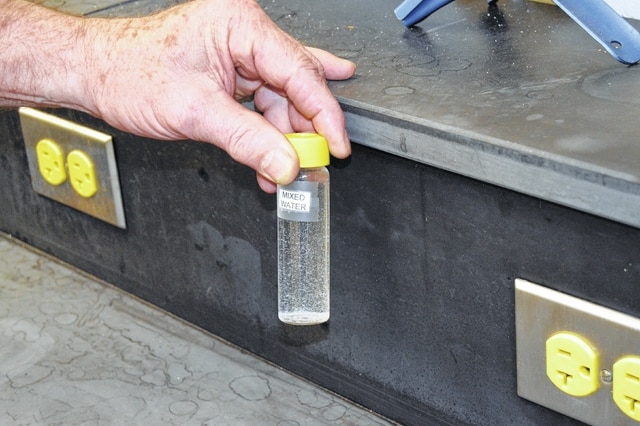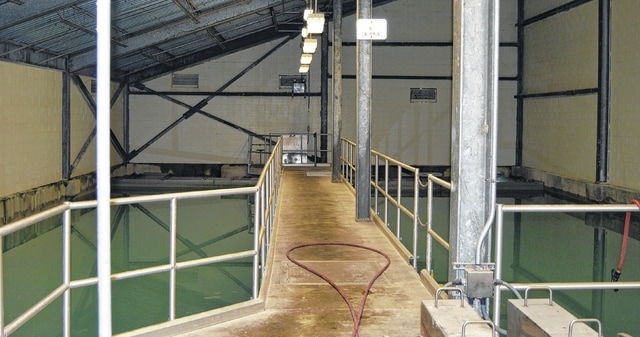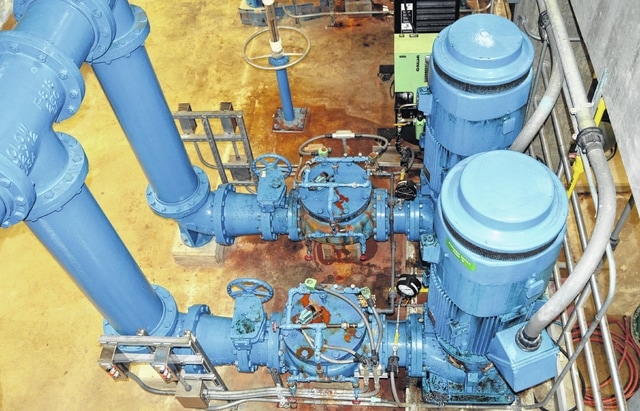


WILMINGTON — There’s a sign that jokingly states “ABSOLUTELY NO SWIMMING” over two long basins of water — the sedimentation basins where city water separates from the added materials used to treat it.
“We get our raw water from Caesar Creek Lake,” said Wilmington Water Department Chief Operator Joe Rae. “It goes through a 24-inch water main for 14 miles or from our reservoirs,” which are used as backups.
Once the water reaches the plant, Rae said, it’s mixed with pebble lime to “soften” the water, which Rae said reduces the amount of dissolved solids in the water and helps people feel cleaner after a shower, for instance.
Then, the plant adds aluminum sulfate, labeled alum. The alum neutralizes the valence charge of particles in the water, Rae said, allowing those particles to stick together so they can be removed later in the sedimentation basins.
Removing solids from water isn’t the only goal in the chemical room. Operators also add powdered activated carbon to give the water better taste and odor because, according to Rae, the algae can add tastes to the water, and “some of them are horrible.”
At that point the water looks as though it has snowflakes in it from the added materials. It then is pumped into two settling rooms.
It will mix there for a while, in a process called flocculation, allowing the particles a chance to bind. Then it moves into two long basins of water, where the “no swimming” sign is.
Rakes and pumps in the basins remove the settled material, discharging it into a couple of lagoons behind the plant. Rae said farmers love the discharged pebble lime and water slurry, which has a high pH value — a measure of something’s acidity or, in this case, basicity. The slurry, Rae said, can be used to replenish pH in soil where anhydrous ammonia has been used as a nitrogen fertilizer.
The basins usually handle two different vats of water simultaneously, but, if necessary, the system could be re-routed so the water flows into one basin then into the other.
“If we had a settling problem, we could double our settling time by changing it from parallel to series,” Rae said.
An equipment malfunction and sometimes colder weather could require using the settling basins in a series.
“Very rarely have we had to go to series,” Rae said.
After settling, carbon dioxide is added to lower the water’s pH level.
Then, the water goes to the filter room, where it filters through three feet of anthracite, a variant of coal, and a foot of sand.
“The EPA limits how much turbidity (material in water) is allowed in the finished water,” Rae said. “In order to meet that requirement, we have to filter it through anthracite and sand.
“Chlorine is then added to the water to kill any pathogens left in the water,” Rea continued. “It then goes to a clear well out in the yard, and the purpose of the clear well is to give the chlorine time – it’s called contact time – to kill the pathogens in the water.”
Some of the parasites the chlorine also kills have hard shells, and it takes the chlorine longer to kill them.
The two clear wells, which Rae descrbied as “big, square, concrete cisterns,” can hold more than 1.3 million gallons.
Ortho/polyphosphate is also added, which Rae said “has a tendency to keep things in suspension, which is good” and prevents lead from being leached off of pipes and entering drinking water, among other effects.
High-pressure pumps move water from there to a person’s house or to a water tower.
The department makes use of four water towers at Prairie Avenue, the Wilmington Air Park, the Clinton County Fairgrounds and one on U.S. 68. Between all four, they can hold 3.25 million gallons.
The towers will be used when both the clear wells and the towers are full, according to Rae.
“We like to let the water cycle,” Rae said. “You can’t let the same water stay up in the air all the time cause it’s going to get stagnant. We flex them every week.”
Reach Nathan Kraatz at 937-382-2574, ext. 2510 or on Twitter @NathanKraatz.




